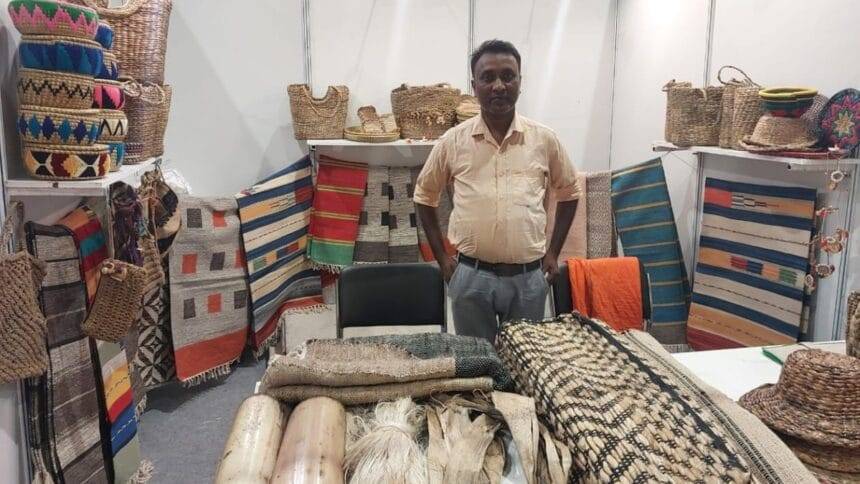Main Points In Hindi (मुख्य बातें – हिंदी में)
उत्तर प्रदेश में केले की खेती के मुख्य बिंदु
-
किसान की सफलता की कहानी: रवि प्रसाद, जो कुशीनगर के हरिहरपुर (टामकुहीराज) के निवासी हैं, ने 2015 में परिवार की जिम्मेदारी उठाते हुए दिल्ली में काम किया और बाद में केले के फाइबर से उत्पाद बनाने का विचार किया।
-
सरकारी योजना का लाभ: उत्तर प्रदेश सरकार की "एक जिला, एक उत्पाद" योजना के तहत कुशीनगर में केले को ODOP (एक जिला, एक उत्पाद) घोषित किया गया, जिससे रवि के आत्मविश्वास में वृद्धि हुई और उन्होंने 5 लाख रुपये का ऋण लेकर अपना व्यवसाय शुरू किया।
-
महिलाओं का सशक्तिकरण: रवि ने न केवल अपने लिए बल्कि 60 से अधिक महिलाओं के लिए रोजगार के अवसर सृजित किए हैं, जो स्वयं सहायता समूहों में काम कर रही हैं।
-
केले के फाइबर से विविध उत्पाद: रवि विभिन्न उत्पाद बनाते हैं जैसे बैग, टोपी, बुके, योगा मैट्स, मोबाइल पर्स आदि, और कुछ फाइबर का निर्यात भी करते हैं।
- फाइबर निकालने की प्रक्रिया: केला का तना पहले काटा जाता है, फिर फाइबर निकालने की मशीन में डालकर फाइबर निकाला जाता है। यह प्रक्रिया केले के फाइबर को रंगने के बाद उत्पादों के निर्माण में उपयोग की जाती है।
ये बिंदु रवि प्रसाद की कहानी और उत्तर प्रदेश में केले की खेती के महत्व को दर्शाते हैं।
Main Points In English(मुख्य बातें – अंग्रेज़ी में)
Here are the main points regarding banana cultivation and its impact on farmers in Uttar Pradesh, as exemplified by the story of Ravi Prasad:


-
Background and Challenge: Ravi Prasad, a resident of Kushinagar, faced significant challenges after his father lost a leg in an accident. This forced him to leave his studies and find work to support his family, which led him to explore opportunities in banana fiber production after attending an exhibition in Delhi.
-
Government Support and Success: The Uttar Pradesh government’s "One District, One Product" (ODOP) initiative identified banana as a key product for Kushinagar, boosting Ravi’s morale. He obtained a loan of ₹5 lakh from the PMEGP scheme, which enabled him to start his banana fiber business in late 2017.
-
Empowerment of Women: Ravi’s success not only improved his livelihood but also benefited over 60 women associated with him through self-help groups. This initiative has helped create social identities and economic opportunities for these women.
-
Diverse Product Range: Ravi’s business produces a variety of items from banana fiber, including bags, mats, caps, and more, with some products being exported to firms in Gujarat. Additionally, the water generated during the fiber extraction process is sold to fish farmers as a nutrient-rich additive.
- Training and Community Impact: Ravi has trained around 600 farmers in creating products from banana fiber, fostering knowledge and skills in the community. The process involves methods that ensure the products are durable and environmentally friendly, thus contributing to sustainable agricultural practices in the region.
Complete News In Hindi(पूरी खबर – हिंदी में)
उत्तर प्रदेश में केला की खेती (केला Farming) किसानों के लिए लाभदायक साबित हो रही है। आज हम एक सफल किसान की कहानी बताने जा रहे हैं, जिसका जीवन उतार-चढ़ाव से भरा रहा। उनका नाम है रवि प्रसाद। वे कुशीनगर के हरिहरपुर (तमकुहींराज) के निवासी हैं। साल 2015 में जब वह अर्थशास्त्र में एमए कर रहे थे, उनके पिता एक गंभीर दुर्घटना में अपना पैर खो दिया। परिवार के एकमात्र बच्चे होने के नाते, उन्हें इस घटना के बाद अपनी पढ़ाई छोड़नी पड़ी और परिवार की जिम्मेदारी उठानी पड़ी। ऐसी स्थिति में, रवि को चारों ओर अंधेरा नजर आ रहा था। जीविका के लिए वह दिल्ली चले गए। इस बीच, प्रगति मैदान में एक प्रदर्शनी में दक्षिण भारत के एक स्टॉल पर केले के फाइबर से बने उत्पाद देखकर उन्हें लगा कि यह काम कुशीनगर में भी किया जा सकता है। उन्होंने कुछ जानकारी के साथ घर वापस लौटकर 2017 के अंत में काम शुरू किया।
इसी दौरान, योगी आदित्यनाथ सरकार ने “एक जिला, एक उत्पाद” (ODOP) नामक एक महत्वाकांक्षी योजना की घोषणा की। जब कुशीनगर में केले को इस योजना के तहत ODOP के रूप में घोषित किया गया, तो उनका मनोबल बढ़ा। उन्होंने पीएमईजीपी योजना से 5 लाख रुपये का ऋण लिया, और समय उनके पक्ष में रहा और काम सफल रहा।
स्व-सहायता समूहों में कई महिलाएं काम करती हैं
आज, केला का फाइबर न केवल उनके जीवन को चमका रहा है, बल्कि उनसे जुड़े 60 से अधिक महिलाओं के जीवन को भी बेहतर बना रहा है। हाल ही में, उन्होंने अपने उत्पादों के साथ ग्रेट नोएडा में योगी सरकार द्वारा आयोजित एक अंतरराष्ट्रीय व्यापार मेले में भाग लिया। उनके सभी सामान बिक गए। आज, वह न केवल आत्मनिर्भर हैं, बल्कि उनके पास एक सामाजिक पहचान भी है। बस अगस्त में, जिले के DM और CDO ने उनकी यूनिट का दौरा किया। उनके अनुसार, योगी सरकार ने केले को ODOP घोषित करके इसकी खेती और इससे जुड़े अन्य कार्यों को नई जिंदगी दी है।
फाइबर से कई उत्पाद बनते हैं, जैसे कि टोपी और गुलदस्ते
वर्तमान में, वह केला के फाइबर से पुरुषों और महिलाओं के लिए बैग, टोपी, गुलदस्ते, पेन स्टैंड, पूजा मैट, योगा मैट, कालीन, कैरी बैग, मोबाइल पर्स, लैपटॉप बैग, चप्पल आदि बनाते हैं। वह कुछ केला के फाइबर को गुजरात की कुछ फर्मों को भी निर्यात करते हैं।
केला का रस 15 से 20 रुपये प्रति लीटर बिकता है
इसके अलावा, केला के फाइबर को अलग करते समय जो पानी निकलता है, वह 15 से 20 रुपये प्रति लीटर के दर से बेचा जाता है। इसके ग्राहक मछली उत्पादन करने वाले लोग हैं। इस पानी में कैल्शियम, पोटेशियम, आयरन, मैग्नीशियम और विटामिन B-6 पाया जाता है। इसे उस तालाब में डाला जाता है जहां मछलियां पाले जाते हैं। इससे मछलियों की वृद्धि में सुधार होता है। इसके अलावा, बचे हुए कचरे को कंपोस्ट करके बेहतरीन जैविक खाद भी बनाई जा सकती है। रवि पहले भी ऐसा करते थे और अब फिर से इसकी तैयारी कर रहे हैं।
अब तक लगभग 600 किसानों को प्रशिक्षण दिया गया है
रवि ने केले के फाइबर से सामान और अन्य उत्पाद बनाने के बारे में लगभग 600 किसानों को प्रशिक्षण दिया है। इसके अलावा, विभिन्न स्व-सहायता समूहों से जुड़ी लगभग 60 से 65 महिलाएं भी उनसे जुड़ी हुई हैं।
केले के तने से फाइबर निकालने और रंगाई की प्रक्रिया
रवि के अनुसार, सबसे पहले केले के तने को केले के पेड़ काटने वाली मशीन में डाला जाता है। यह तने को कई टुकड़ों में काट देती है। फिर उन टुकड़ों को फाइबर बनाने की मशीन में डाल दिया जाता है। इस दौरान, केले के तने से निकले रस में थोड़ा सा नमक डालकर आवश्यकता अनुसार गर्म किया जाता है। इसके बाद, इस फाइबर को इच्छित रंग में रंगा जाता है और उत्पाद बनाने में इस्तेमाल किया जाता है। रंग पूरी तरह स्थायी होता है और फाइबर से बने उत्पाद जूट के उत्पादों से लगभग 30 प्रतिशत अधिक मजबूत होते हैं।
Complete News In English(पूरी खबर – अंग्रेज़ी में)
Banana cultivation in Uttar Pradesh (Banana Farming) It is proving beneficial for the farmers. Today we are going to tell the story of a successful farmer whose life was full of ups and downs. Name is Ravi Prasad. He is a resident of Hariharpur (Tamkuhiraj) of Kushinagar. In the year 2015, when he was doing MA in Economics, his father lost his leg in a serious accident. Being the only child of the family, he had to leave his studies after this accident. Responsibility of the house in front. In such a situation, Rabi was seeing darkness all around. Went to Delhi for livelihood. Meanwhile, after seeing all the products made from banana fiber at a stall in South India in the exhibition at Pragati Maidan, it came to my mind that this work is possible in Kushinagar also. Returned home with some basic information. Work started in late 2017.
Meanwhile, the Yogi Adityanath government announced an ambitious scheme named One District, One Product (ODOP). Their morale was boosted when banana was declared as ODOP of Kushinagar under the scheme. He took a loan of Rs 5 lakh from the PMEGP scheme, and time favored him and the work was done.
Many women work in self-help groups
Today, banana fiber is brightening not only his life but also the lives of more than five dozen women associated with him. Recently he also went to the International Trade Show organized by Yogi Government in Great Noida with his products. All his belongings were sold. Today, not only is he self-reliant, but he also has a social identity. Just in August, the DM and CDO of the district had visited his unit. According to him, by declaring banana as ODOP (ODOP) of Kushinagar, the Yogi government has given new life to its cultivation and other works related to it.
Many products including hats and bouquets are made from fibre.
At present, he makes bags, caps, bouquets, pen stands, puja mats, yoga mats, carpets, carry bags, mobile purses, laptop bags, slippers etc. for women and men from banana fiber. He also exports some banana fiber to some firms in Gujarat.
Banana juice is sold for Rs 15 to 20 a liter
Not only this, the water that comes out while separating the fiber from banana is also sold at the rate of Rs 15 to 20 per litre. Its customers are fish producing people. Calcium, potassium, iron, magnesium and vitamin B-6 are found in this water. It is put in the pond where fish are reared. This improves the growth of fishes. Not only this, excellent organic fertilizer can be made by composting the remaining waste also. Rabi used to make it earlier too. Preparing for this once again.
Till now around 600 farmers have been given training
Rabi has given training to about 600 farmers regarding making goods and other products from banana fiber. Apart from this, about 60 to 65 women associated with different self-help groups are also associated with them.
Process of extracting fiber from banana stem and dyeing it
According to Ravi, first of all the stem is put in the banana tree cutter. She tears the stem into many pieces. Then the separate pieces of stem are put into the fiber making machine. The fiber comes out from this. During this time, add a little Namaak to the juice extracted from banana stem and heat it as per requirement. After this, this fiber is dyed in the desired color and used in making products. The color is absolutely stable and the products made from the fiber are about 30 percent stronger than jute products.






